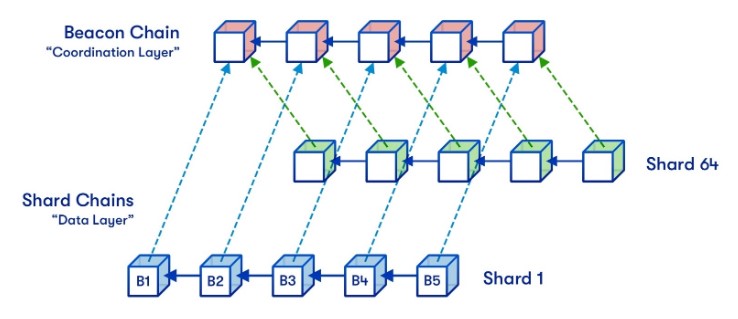Ever since its inception Ethereum has been using the Proof-of-Work (PoW) consensus mechanism. Since it has proven to be a reliable and resilient way to validate transactions in a decentralised manner (especially by its bigger brother - Bitcoin), Vitalik Buterin and other co-creators decided that it was the most appropriate consensus protocol for what they were about to develop. Regardless of the relevance of Proof-of-Work in Ethereum’s infancy, sooner rather than later it became clear that the blockchain will eventually have to move to a different consensus mechanism.
Why? It is in the nature of Ethereum’s original consensus mechanism that the difficulty level of computational mathematics increases exponentially every 100,000 blocks. The increased difficulty forces miners to spend more resources to receive their rewards, which makes mining less profitable, as well as more energy consuming over time. Moreover, the proof-of-stake (PoS) offers more security and better scalability.
How the transition began?
Consequently developers have started planning a move from PoW to PoS, but changing a blockchain consensus mechanism is no piece of cake. The preparation for a transition started on the 1st December of 2020 the Beacon chain set sail, introducing the proof-of-stake to Ethereum. The new engine of block production has shipped separately from the Mainnet and has been running in parallel using PoS.
All this time, instead of processing Mainnet transactions, the Beacon chain has been reaching consensus on its own state by agreeing on active validators and their account balances. With the merge, Ethereum will adopt the Beacon chain as the new consensus layer to the current Mainnet execution layer and will also validate other network data, including execution layer transactions and account balances.
 Source: ethereum.org
Source: ethereum.org
It has required almost two years of research, development and extensive testing to ensure a smooth transition and we’re about to reap the benefits of all the hard work that has been going on behind the scenes.
When will the transition be completed?
The transition will be completed once the Beacon chain successfully merges with the Ethereum Mainnet which has been operating on a proof-of-work consensus mechanism. When it comes to the time of transition, the latest estimate predicts it will happen on Thursday (15th September). Why no specific time and date? Every block mined on Ethereum's Mainnet has a difficulty number attached to it. This number shows how difficult it was for miners to add it to the network. The Merge is scheduled to happen once the cumulative difficulty (Total terminal difficulty) of all mined Ethereum blocks hits 58,750,000,000,000,000,000,000 and analysts believe it will happen on 15th September.

The foremost improvement that transition from PoW to PoS brings about is significantly improved energy efficiency. According to the Ethereum Foundation, by validating transactions by chosen validators instead of having miners solve difficult cryptographic problems, the new consensus mechanism will cut Ethereum’s energy usage by a staggering 99.95%. Proof-of-stake also helps reduce centralization risk, as the transition should lead to more nodes securing the network. Why?
Since PoS drastically reduces hardware requirements needed for participation in transaction validating, it effectively lowers a barrier to entry and consequently helps further decentralise the network. Theoretically, anyone can stake which means everyone can participate. The only drawback is that, in order to become a validator, you need to stake 32 ETH, which translates to almost $60k, taking into account the current ETH value of just below $1,800. Fortunately there is an alternative, as you can also participate by staking your ETH on centralised exchanges such as Kucoin or Binance.
A transition from PoS to PoW also drastically reduces the possibility of a 51% attack (a malicious attack by a group of miners that control more than 50% of the network's mining hash rate), as validators may lose their whole stake in case they tried to validate illegitimate transactions. In case of PoW the 51% attack is highly unlikely, but practically still possible. If the attackers were able to get their hands on more than half of the computational power, they could prevent new transactions from getting confirmed or even reverse transactions. With the introduction of the PoS, the community can resort to social recovery of an honest chain if a 51% attack occurred despite its almost non-existent probability.
What is the next step after the merge?
The upcoming merge won’t only mark the end of Ethereum’s energy-intensive PoW chapter and open doors to the more eco-friendly PoS, but also set the stage for further scalability upgrades not possible under PoW. Which scalability upgrades? The first focus of developers, following the merge of mainnet with the Beacon chain, will be Sharding, which will increase the Ethereum network throughput (transactions per second), while reducing transaction fees, by splitting the network into multiple smaller parts called 'shards.'
 Source: vitalik.ca
Source: vitalik.caEach shard will contain its own independent state, which includes a distinct set of account balances and smart contracts. This way nodes aren’t responsible for validating every transaction broadcasted on the Ethereum network, plus keeping a full copy of the Ethereum ledger (which is approaching 1TB of storage), but manage solely transactions attributed to their shard.
Conclusion
On the 15th September we will witness what is probably the biggest structural change in the history of crypto. It’s one thing to launch a new system/protocol when you have no users, it’s another thing to do so when there are billions of dollars (Etherium’s market cap is currently sitting at just above $200 billion) and millions of people relying on the network and a small error could lead to a disaster. We’re keeping our fingers crossed everything turns out in accordance with the plan.




